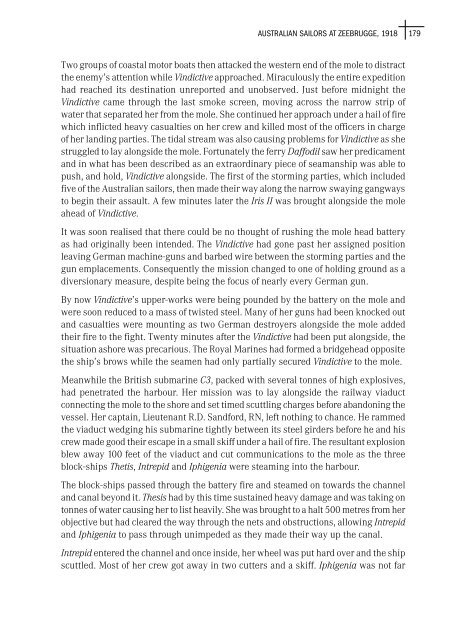Australian Maritime Issues 2007 - Royal Australian Navy
Australian Maritime Issues 2007 - Royal Australian Navy
Australian Maritime Issues 2007 - Royal Australian Navy
Create successful ePaper yourself
Turn your PDF publications into a flip-book with our unique Google optimized e-Paper software.
<strong>Australian</strong> Sailors at Zeebrugge, 1918<br />
179<br />
Two groups of coastal motor boats then attacked the western end of the mole to distract<br />
the enemy’s attention while Vindictive approached. Miraculously the entire expedition<br />
had reached its destination unreported and unobserved. Just before midnight the<br />
Vindictive came through the last smoke screen, moving across the narrow strip of<br />
water that separated her from the mole. She continued her approach under a hail of fire<br />
which inflicted heavy casualties on her crew and killed most of the officers in charge<br />
of her landing parties. The tidal stream was also causing problems for Vindictive as she<br />
struggled to lay alongside the mole. Fortunately the ferry Daffodil saw her predicament<br />
and in what has been described as an extraordinary piece of seamanship was able to<br />
push, and hold, Vindictive alongside. The first of the storming parties, which included<br />
five of the <strong>Australian</strong> sailors, then made their way along the narrow swaying gangways<br />
to begin their assault. A few minutes later the Iris II was brought alongside the mole<br />
ahead of Vindictive.<br />
It was soon realised that there could be no thought of rushing the mole head battery<br />
as had originally been intended. The Vindictive had gone past her assigned position<br />
leaving German machine-guns and barbed wire between the storming parties and the<br />
gun emplacements. Consequently the mission changed to one of holding ground as a<br />
diversionary measure, despite being the focus of nearly every German gun.<br />
By now Vindictive’s upper-works were being pounded by the battery on the mole and<br />
were soon reduced to a mass of twisted steel. Many of her guns had been knocked out<br />
and casualties were mounting as two German destroyers alongside the mole added<br />
their fire to the fight. Twenty minutes after the Vindictive had been put alongside, the<br />
situation ashore was precarious. The <strong>Royal</strong> Marines had formed a bridgehead opposite<br />
the ship’s brows while the seamen had only partially secured Vindictive to the mole.<br />
Meanwhile the British submarine C3, packed with several tonnes of high explosives,<br />
had penetrated the harbour. Her mission was to lay alongside the railway viaduct<br />
connecting the mole to the shore and set timed scuttling charges before abandoning the<br />
vessel. Her captain, Lieutenant R.D. Sandford, RN, left nothing to chance. He rammed<br />
the viaduct wedging his submarine tightly between its steel girders before he and his<br />
crew made good their escape in a small skiff under a hail of fire. The resultant explosion<br />
blew away 100 feet of the viaduct and cut communications to the mole as the three<br />
block-ships Thetis, Intrepid and Iphigenia were steaming into the harbour.<br />
The block-ships passed through the battery fire and steamed on towards the channel<br />
and canal beyond it. Thesis had by this time sustained heavy damage and was taking on<br />
tonnes of water causing her to list heavily. She was brought to a halt 500 metres from her<br />
objective but had cleared the way through the nets and obstructions, allowing Intrepid<br />
and Iphigenia to pass through unimpeded as they made their way up the canal.<br />
Intrepid entered the channel and once inside, her wheel was put hard over and the ship<br />
scuttled. Most of her crew got away in two cutters and a skiff. Iphigenia was not far
















